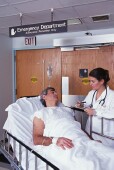
TUESDAY, Sept. 10 (HealthDay News) — The United States faces a cancer care crisis because of its aging population, rising health costs, complexity of care and a shrinking pool cancer care workers, a new report warns.
The number of people over 65 — the segment of the population that accounts for most cancer cases — is rapidly increasing, straining available health services, according to the Institute of Medicine (IOM), which advises the federal government on health issues.
What’s needed is a shift toward patient-centered, evidence-based care, the IOM report said.
“Most clinicians caring for cancer patients are trying to provide optimal care, but they’re finding it increasingly difficult because of a range of barriers,” said Patricia Ganz, chairwoman of the committee that wrote the report and a professor at the School of Medicine and School of Public Health at the University of California, Los Angeles.
“As a nation, we need to chart a new course for cancer care,” Ganz said in an institute news release. “Changes are needed across the board, from how we communicate with patients to how we translate research into practice to how we coordinate care and measure its quality.”
More than 1.6 million new cancer cases are diagnosed each year in the United States, and that is expected to rise to 2.3 million new cancer diagnoses per year by 2030, the report said. Soon there may be too few cancer care workers to care for the rising number of people diagnosed with cancer, and training programs lack the ability for rapid expansion, the researchers said.
To improve delivery of cancer care, the report recommended improving doctors’ core skills in caring for cancer patients, shifting to team-based models of care and communicating more effectively with patients.
In addition, the complexity of cancer and its treatment has grown in recent years, presenting other challenges. Doctors, patients and patients’ families often find it difficult to develop care plans with the necessary speed, precision and quality.
Another major issue is the cost of cancer care, which increased from $72 billion in 2004 to $125 billion in 2010. At the current rate, it will increase another 39 percent to $173 billion by 2020, according to the report.
The report outlined the following strategies for improving cancer care:
- Supportive decision-making. The cancer care system needs to support patients in making informed medical decisions that match their needs, values and preferences. Cancer care teams should provide patients and their families with understandable information about cancer prognosis and the benefits, harms and costs of treatments.
- Team-based cancer care. This requires a workforce that is adequately staffed, trained and coordinated.
- Evidence-based cancer care. Researchers should investigate the benefits and harms of various treatment options so doctors, patients and patients’ families can be more informed when making treatment decisions. This information needs to include the impact of treatments on quality of life, symptoms and patients’ overall experience with the disease.
- A “learning” information technology system. This is a system that can “learn” by enabling real-time analysis of data from cancer patients in a variety of care settings to improve knowledge and help guide medical decisions. Such a system should be developed by the federal government and professional medical groups.
- Accessible and affordable cancer care. Currently, access to cancer care can be difficult for the poor, racial and ethnic minorities, seniors, and those without health insurance. The federal government should develop a national strategy to provide accessible and affordable cancer care.
More information
The American Academy of Family Physicians has more about cancer treatment.
Copyright © 2025 HealthDay. All rights reserved.

